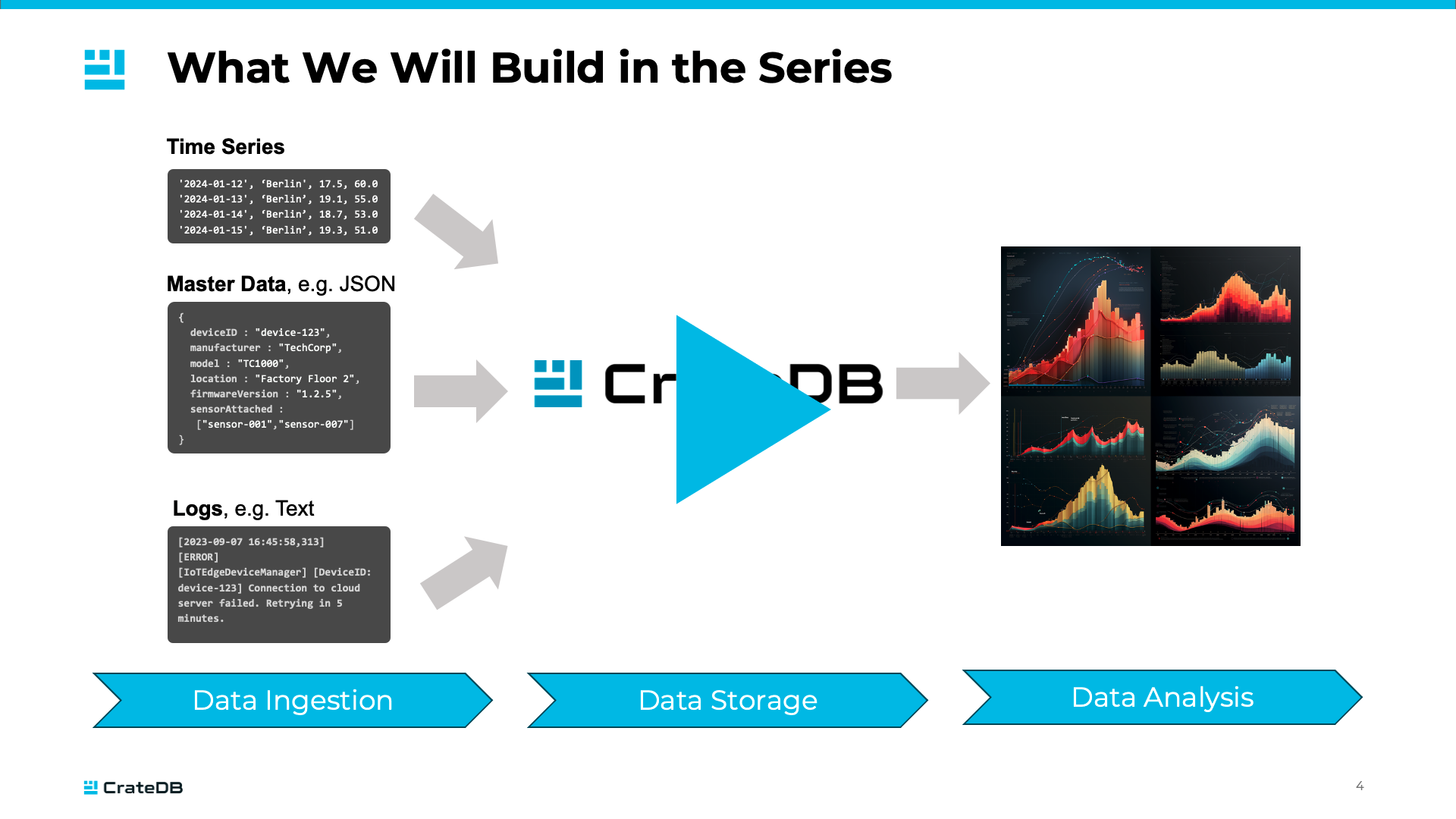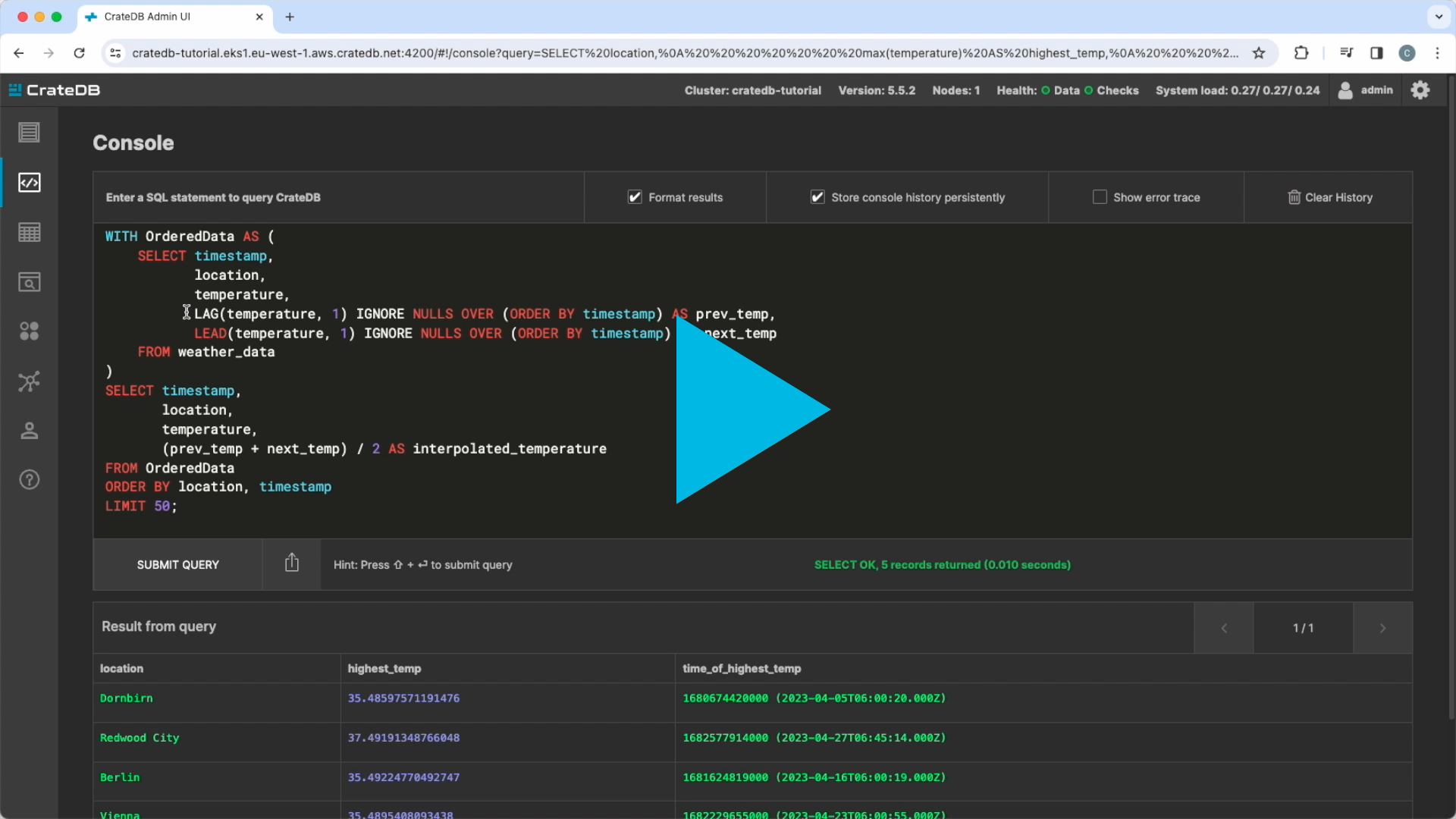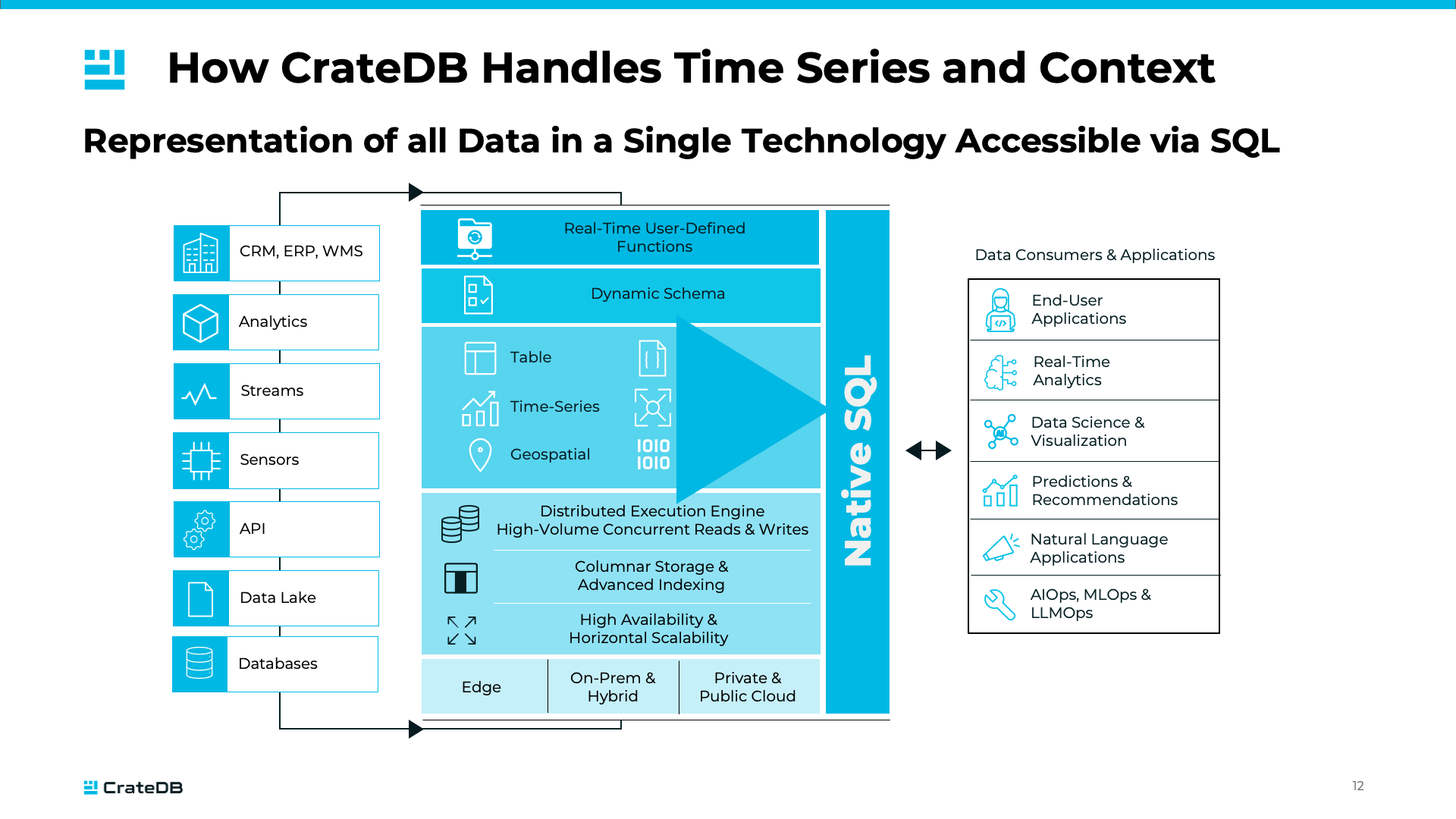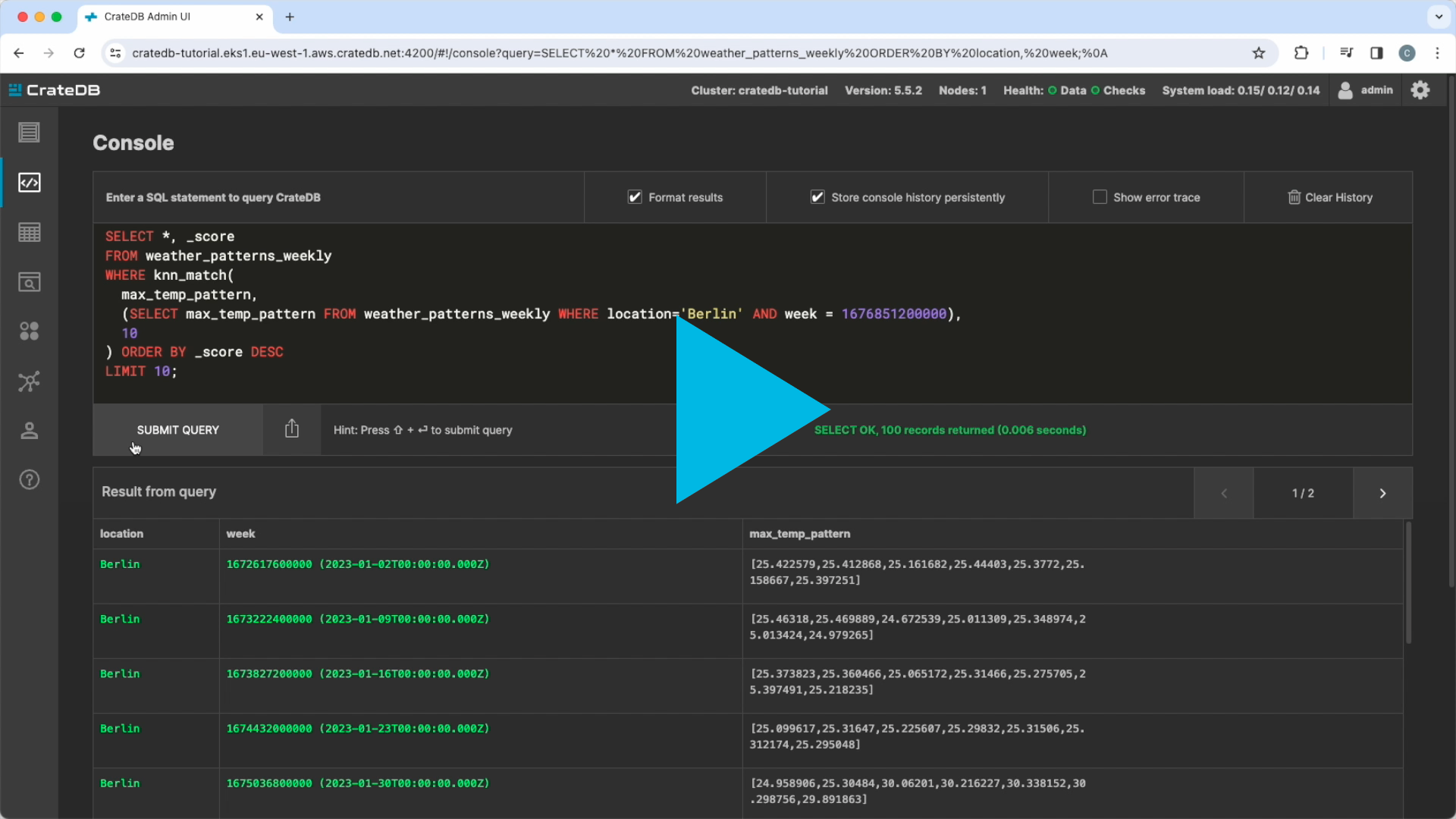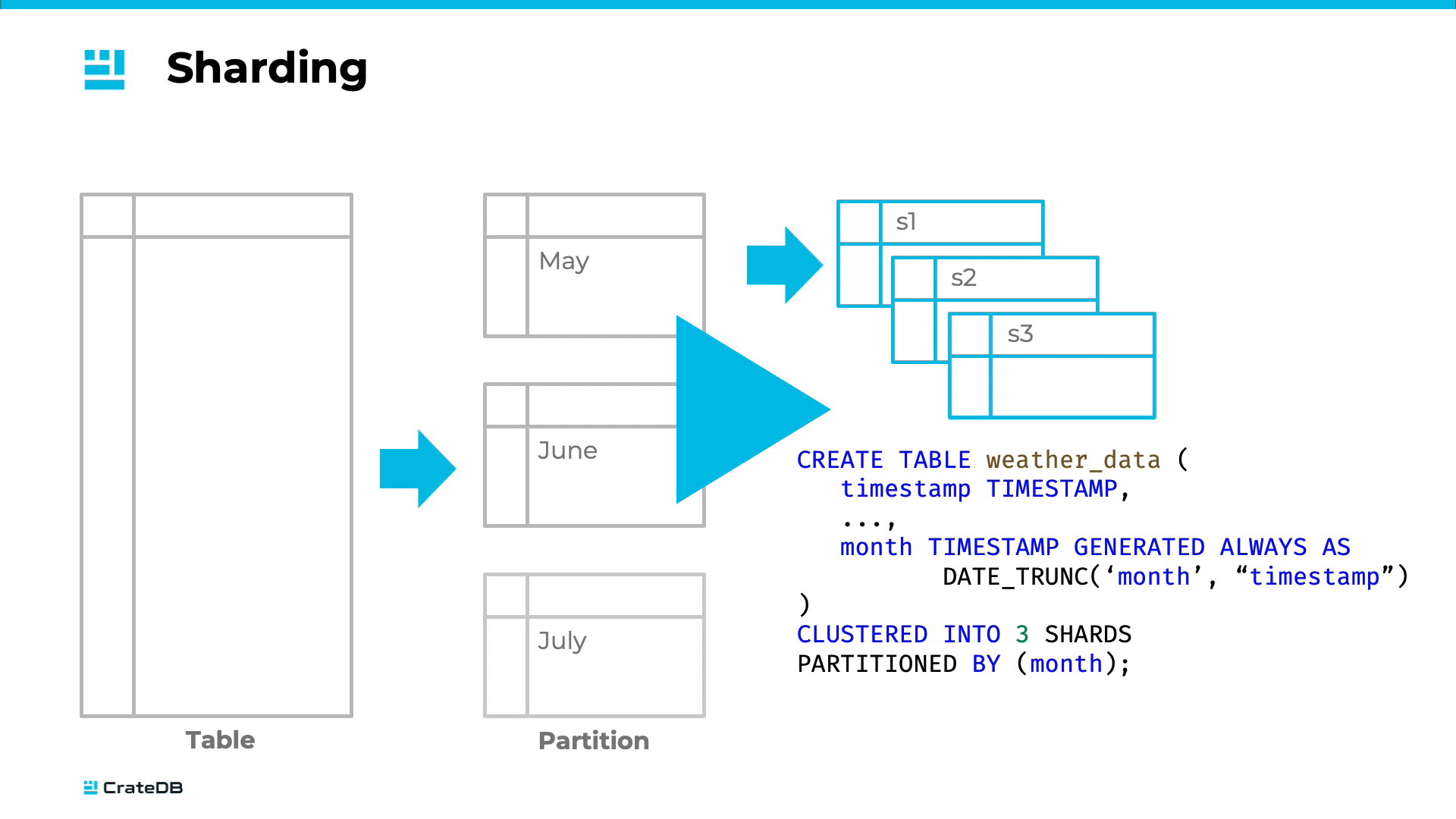Time Series Database
Time series database with SQL
Hyper-fast. Results in milliseconds.
/* Based on device data, this query returns the average
* of the battery level for every hour for each device_id
*/
WITH avg_metrics AS (
SELECT device_id,
DATE_BIN('1 hour'::INTERVAL, time, 0) AS period,
AVG(battery_level) AS avg_battery_level
FROM devices.readings
GROUP BY 1, 2
ORDER BY 1, 2
)
SELECT period,
t.device_id,
manufacturer,
avg_battery_level
FROM avg_metrics t, devices.info i
WHERE t.device_id = i.device_id
AND model = 'mustang'
LIMIT 10;
+---------------+------------+--------------+-------------------+
| period | device_id | manufacturer | avg_battery_level |
+---------------+------------+--------------+-------------------+
| 1480802400000 | demo000001 | iobeam | 49.25757575757576 |
| 1480806000000 | demo000001 | iobeam | 47.375 |
| 1480802400000 | demo000007 | iobeam | 25.53030303030303 |
| 1480806000000 | demo000007 | iobeam | 58.5 |
| 1480802400000 | demo000010 | iobeam | 34.90909090909091 |
| 1480806000000 | demo000010 | iobeam | 32.4 |
| 1480802400000 | demo000016 | iobeam | 36.06060606060606 |
| 1480806000000 | demo000016 | iobeam | 35.45 |
| 1480802400000 | demo000025 | iobeam | 12 |
| 1480806000000 | demo000025 | iobeam | 16.475 |
+---------------+------------+--------------+-------------------+
/* To identify gaps on the readings, the following queries generates a series
* and by joining it with the original data, you can spot any gap */
with avg_battery AS (
SELECT battery_level, time
FROM devices.readings
WHERE device_id = 'demo000007'
AND time > 1480118400000
AND time < 1480301200000
ORDER BY 2
),
all_hours AS (
SELECT generate_series(1480118430000,1480301200000,'30 second'::interval) AS generated_hours
)
SELECT time, generated_hours, battery_level
FROM all_hours
LEFT JOIN avg_battery ON generated_hours = time
ORDER BY 2
LIMIT 20;
+---------------+---------------+---------------+
| time | hours | battery_level |
+---------------+---------------+---------------+
| 1480118430000 | 1480118430000 | 67 |
| 1480118460000 | 1480118460000 | 66 |
| 1480118490000 | 1480118490000 | 66 |
| 1480118520000 | 1480118520000 | 66 |
| 1480118550000 | 1480118550000 | 66 |
| 1480118580000 | 1480118580000 | 66 |
| 1480118610000 | 1480118610000 | 65 |
| 1480118640000 | 1480118640000 | NULL |
| 1480118670000 | 1480118670000 | 65 |
| 1480118700000 | 1480118700000 | 65 |
| 1480118730000 | 1480118730000 | 65 |
| 1480118760000 | 1480118760000 | 65 |
| 1480118790000 | 1480118790000 | 65 |
| 1480118820000 | 1480118820000 | 65 |
| 1480118850000 | 1480118850000 | 65 |
| 1480118880000 | 1480118880000 | 65 |
| 1480118910000 | 1480118910000 | 65 |
| 1480118940000 | 1480118940000 | 65 |
| 1480118970000 | 1480118970000 | NULL |
| 1480119000000 | 1480119000000 | NULL |
+---------------+---------------+---------------+
/* Based on device data, this query returns the number of battery charges
* per day for a given device_id */
WITH aux_charging AS (
SELECT time,
DATE_BIN('P1D'::INTERVAL,time,0) AS day,
battery_status,
LAG(battery_status) OVER (PARTITION BY device_id ORDER BY time) AS prev_battery_status
FROM devices.readings
WHERE device_id = 'demo000001'
ORDER BY time
),
count_start_charging AS (
SELECT day, (case when battery_status <> prev_battery_status then 1 else 0 end) AS start_charging
FROM aux_charging
ORDER BY 1
)
SELECT day, sum(start_charging) as charges_number
FROM count_start_charging
GROUP BY 1
ORDER BY 1;
+---------------+---------------+
| count_charges | day |
+---------------+---------------+
| 2 | 1479168000000 |
| 4 | 1479254400000 |
| 2 | 1479340800000 |
| 10 | 1479427200000 |
| 7 | 1479600000000 |
| 8 | 1479686400000 |
| 6 | 1479772800000 |
| 11 | 1479859200000 |
| 5 | 1480032000000 |
| 7 | 1480118400000 |
| 6 | 1480204800000 |
| 10 | 1480291200000 |
| 3 | 1480464000000 |
| 3 | 1480550400000 |
| 7 | 1480636800000 |
| 2 | 1480723200000 |
+---------------+---------------+
/* Based on device data, this query returns the average of the battery temperature
* for each OS version */
SELECT device_info['os_name'], avg(battery_temperature)
FROM "devices"."readings"
GROUP BY 1
LIMIT 100;
+---------+--------------------------+
| os_name | avg(battery_temperature) |
+---------+--------------------------+
| 4.4.4 | 90.85937893039049 |
| 5.1.0 | 90.86754559738132 |
| 6.0.1 | 90.84230101265824 |
| 5.0.0 | 90.8574802739726 |
+---------+--------------------------+
Columnar storage

High cardinality
CrateDB offers robust support for time partitioning. It enables data to be stored long-term without any need for aggregation or down-sampling. This is crucial because the original, un-aggregated data often contains granular details that may be lost during aggregation. By preserving this level of detail, you get enhanced flexibility to revisit historical data for new insights, or conduct precise forecasting, which is crucial to strategic decision-making processes.
With CrateDB, you can also move your old partitions to slow but cheap spinning disks, while keeping the most recent data on fast SSDs, all while retaining fast query speed for most recent data, and not loosing any details in older data.

Time series functionality
CrateDB includes built-in time-series functionality, such as window functions and time-based indexes. These features make it easier to query and analyze the data, and can improve query performance.
LEADandLAGfunctions, withIGNORE NULLSoption, to fill and extrapolate missing data.DATE_BINfunction to resample the data and use the same intervals on the time axis.WINDOWfunction.JOINoperator to easily combine time series data in one table and corresponding metadata in another table. This avoids pushing too much data in your application.

Much more than a time series database
CrateDB offers a much broader scope; it is built for any type of data and you can combine them all into the same database: structured, unstructured, time-series, geospatial, BLOB and vector data. This way, you can easily cover most of your needs, without investing in some new costly technology that needs complex maintenance and data synchronization.

SQL interface

Integrations
CrateDB integrates seamlessly with popular modern data visualization tools like Grafana, or libraries like Matplotlib. It also offers compatibility with the Java- and Python-based data ecosystem and corresponding libraries and frameworks such as pandas, Dask, or Spark, to facilitate efficient analysis and visualization of time series data.

Distributed architecture
CrateDB is a distributed database that can scale horizontally across multiple nodes. This makes it an ideal fit for time series workloads, which often involve handling large volumes of data from multiple different sources (sensors, IoT gateways, CRM, ERP...) that need to be ingested, enriched and processed on the fly to serve many simultaneous data consumers in real-time.

Open source

Time Series Video Tutorials
Top 8 Most Asked Questions
Discover some of the common questions around time-series databases, including their advantages over traditional databases, best practices for managing them, and the industries that can benefit the most from their adoption. This white paper contains 8 essential things you need to know about time-series databases.
Guide for Time Series Data Projects
This comprehensive guide covers everything you need to know to get started with a time series data project.
How to Get the Most Out of Your Time Series Data
In this recorded webinar, you will dive into the dynamic world of time series data and discover how to solve most problems faced when analyzing time series data.
Documentation and tutorials
Use cases: successful companies adopting a time series database



Want to know more?
101 for Time-Series databases
- What is a time series database?
- Key criteria for selecting a time series database.
